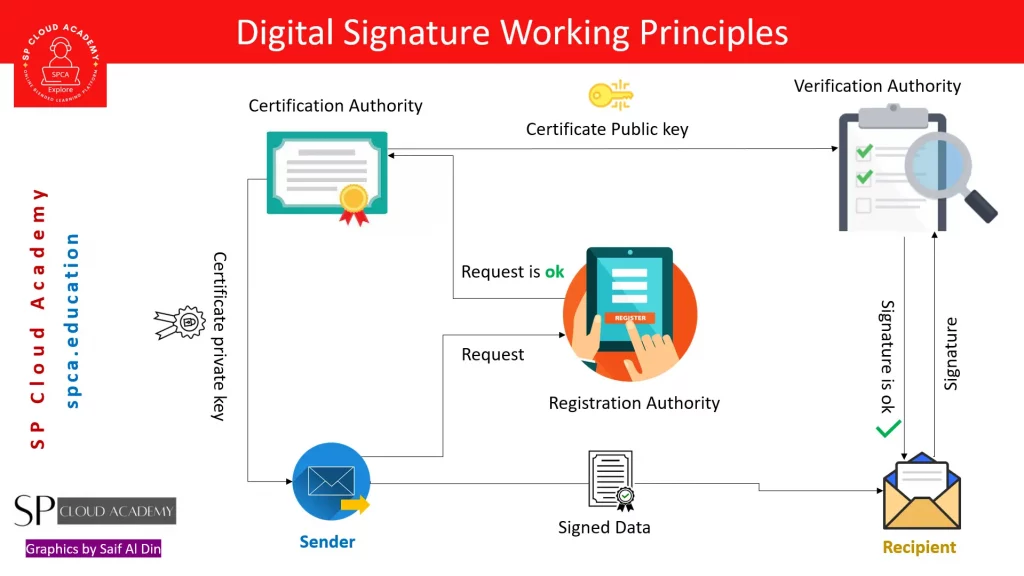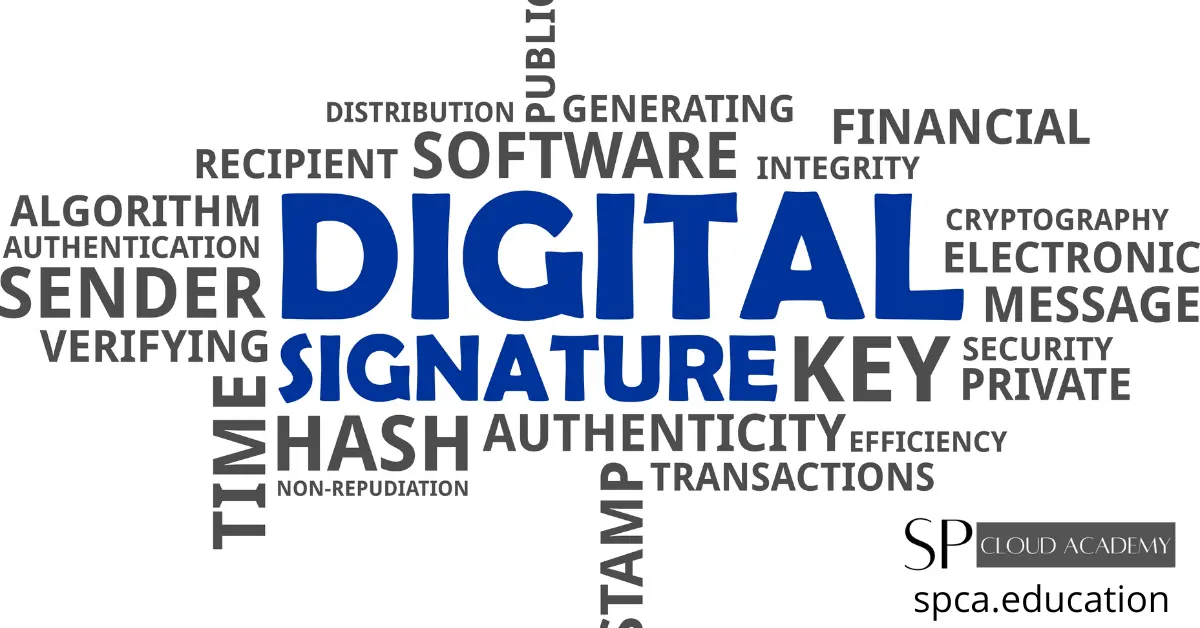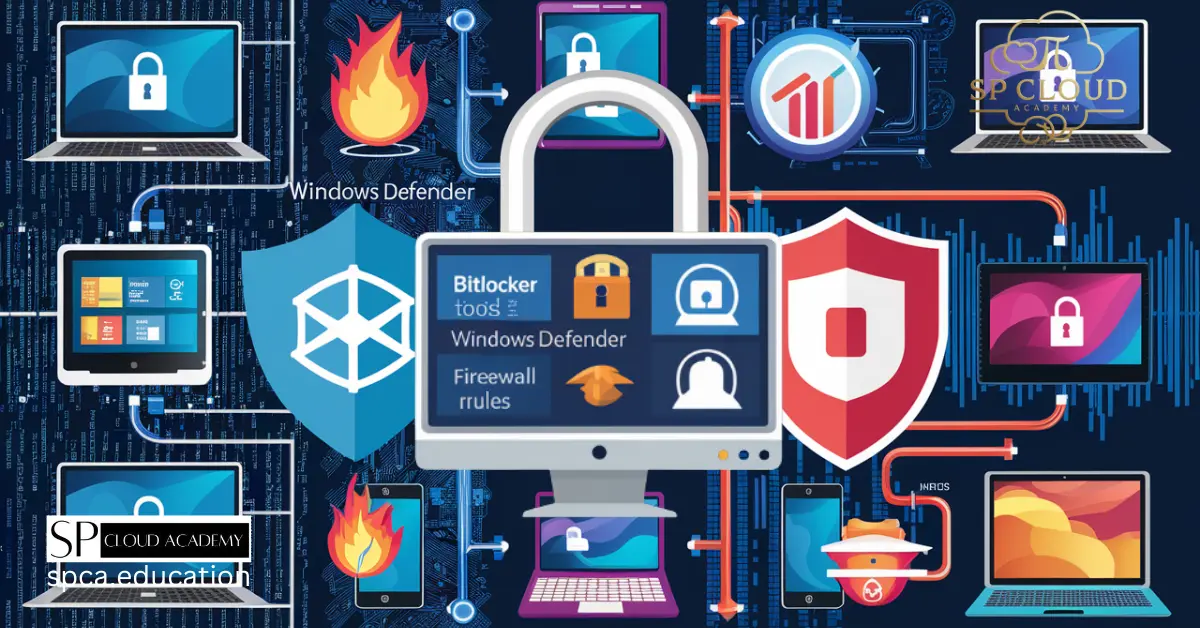Digital Signature is a mathematical scheme for verifying the authenticity of digital messages or documents. A valid digital signature on a message gives a recipient confidence that the message came from a sender known to the recipient and that the message has not been altered in transit.
Digital signatures are created using a pair of keys: a private key and a public key. The private key is kept secret by the signer, while the public key is made available to anyone who wants to verify the signature.
To create a digital signature, the signer uses their private key to encrypt a hash of the message. A hash is a unique value that is generated from the message. It is impossible to recreate the original message from the hash, even if the message is modified.
The encrypted hash is then attached to the message. When the recipient receives the message, they use the signer’s public key to decrypt the hash. If the hash matches the hash of the message, the recipient can be confident that the message came from the signer and that it has not been tampered with.
Here’s how a digital signature generally works:
- Hashing: The sender of the message or document creates a unique hash (a fixed-length string of characters) that represents the content of the message. This hash is generated using a hash function, which takes the entire content of the message as input and produces a fixed-size output.
- Signing: The sender then uses their private key to encrypt the hash. This encrypted hash serves as the digital signature. The private key is a part of a public-key cryptography system, where the private key is known only to the sender and the corresponding public key is known to anyone who wants to verify the signature.
- Verification: The recipient of the message can use the sender’s public key to decrypt the encrypted hash and obtain the original hash. They can then independently calculate the hash of the received message. If the two hashes match, it means that the content of the message has not been altered since the digital signature was created. If the hashes don’t match or if the decryption fails, it indicates that the message might have been tampered with or that the signature is not valid.

Digital signatures offer several benefits, including:
- Authentication: They verify the identity of the sender, as the private key used to create the signature is unique to the sender.
- Integrity: They ensure that the content of the message remains unchanged during transit.
- Non-Repudiation: A sender cannot deny sending a message once they have digitally signed it, as their private key is required to create the signature.
- Security: They provide a strong level of security against unauthorized access and tampering.
Digital signatures are a crucial component of secure communication, especially in applications such as email encryption, online contracts, software distribution, and more. They play a vital role in establishing trust and preventing fraudulent activities in digital environments.
Electronic vs Digital Signature
Electronic signatures and digital signatures are both ways of signing documents electronically, but they have different levels of security and legal enforceability.
- Electronic signatures: Electronic signatures are the most basic type of electronic signature. They can be created using a variety of methods, such as typing your name, clicking a button, or drawing your signature with a mouse. Electronic signatures are not as secure as digital signatures, but they are generally legally enforceable.
- Digital signatures: Digital signatures are more secure than electronic signatures because they use cryptography to verify the identity of the signer and the authenticity of the document. Digital signatures are created using a pair of keys: a private key and a public key. The private key is kept secret by the signer, while the public key is made available to anyone who wants to verify the signature.
Here is a table summarizing the key differences between electronic signatures and digital signatures:
| Feature | Electronic Signature | Digital Signature |
| Security | Less secure | More secure |
| Legal enforceability | Generally legally enforceable | Generally legally enforceable, but there may be exceptions |
| Cost | Typically less expensive | Typically more expensive |
Digital signature providers
There are several reputable digital signature providers that offer solutions for creating and verifying digital signatures. Keep in mind that the landscape may have evolved since then, so it’s a good idea to research and compare current options. Here are some well-known digital signature providers:
Adobe Sign: Adobe Sign offers a comprehensive digital signature solution that integrates with popular document management and workflow tools. It provides a user-friendly interface and compliance with various industry regulations.
DocuSign: DocuSign is one of the most widely recognized digital signature platforms, used for electronic signatures and document management. It’s suitable for businesses of all sizes and offers various features like templates, integration, and mobile support.
HelloSign: Acquired by Dropbox, HelloSign focuses on simplicity and ease of use. It provides features for electronic signatures, document templates, and integrations with popular cloud storage services.
SignEasy: SignEasy is known for its user-friendly mobile app that allows you to sign documents on the go. It’s suitable for individuals, small businesses, and professionals.
OneSpan Sign (formerly eSignLive): OneSpan Sign offers secure digital signature solutions, particularly for industries with strict compliance requirements, such as finance and healthcare.
SignNow: SignNow offers electronic signature and document management solutions with features like templates, workflows, and integrations.
PandaDoc: PandaDoc provides document automation and digital signature capabilities, making it suitable for businesses looking to streamline their document workflows.
Zoho Sign: Zoho Sign is part of the Zoho suite of productivity tools and provides electronic signature capabilities with integration options for other Zoho products.
Remember to assess your specific needs, such as integration requirements, security features, compliance with industry regulations, and pricing, when choosing a digital signature provider. Additionally, consider checking for any new providers that may have emerged after my last knowledge update.
FAQs
Here are some frequently asked questions (FAQs) about digital signatures:
- What is a digital signature?
A digital signature is a cryptographic technique used to validate the authenticity and integrity of digital messages, documents, or transactions. It involves the use of a private key to sign the data, and a corresponding public key to verify the signature. - How does a digital signature work?
When a digital signature is created, a mathematical algorithm processes the data being signed along with the signer’s private key to generate a unique digital signature. This signature can be verified by anyone who has access to the signer’s public key, ensuring the data’s origin and integrity. - What is the difference between a digital signature and an electronic signature?
An electronic signature is a broader term that includes any electronic indication of intent to agree to or approve the contents of a document or transaction. A digital signature is a specific type of electronic signature that uses cryptographic techniques to ensure authenticity and integrity. - Are digital signatures legally binding?
Yes, in most jurisdictions, digital signatures are legally binding and hold the same legal status as handwritten signatures. However, the specific regulations and requirements may vary by country or region. - What are the benefits of using digital signatures?
Digital signatures offer several advantages, including enhanced security, tamper-proofing of documents, reduced paperwork, increased efficiency, and faster transaction processing. - What is a digital certificate?
A digital certificate, also known as a public key certificate, is an electronic document that links a public key to the entity that holds it. It is issued by a Certificate Authority (CA) and serves as a way to verify the authenticity of the public key holder. - What is a Certificate Authority (CA)?
A Certificate Authority is a trusted third-party organization that issues digital certificates and verifies the identities of the entities requesting them. CAs play a crucial role in establishing the trustworthiness of digital signatures. - Can a digital signature be forged?
While digital signatures are designed to be extremely secure and difficult to forge, no system is entirely immune to attacks. Proper key management practices, strong encryption, and adherence to security protocols can significantly reduce the risk of forgery. - Where are digital signatures commonly used?
Digital signatures are used in various applications, including email communication, software distribution, e-commerce transactions, contract management, and legal documentation. - Do I need special software to create or verify digital signatures?
Yes, you typically need digital signature software or tools to create and verify digital signatures. Many software applications and online platforms provide this functionality. - Are there any legal or regulatory requirements for using digital signatures?
Yes, different countries and industries may have specific legal and regulatory requirements for the use of digital signatures. It’s important to understand and comply with the relevant laws and regulations in your jurisdiction. - Can I use the same digital signature for multiple documents?
While you can use the same private key to sign multiple documents, it’s generally recommended to use a unique signature for each document to maintain security and individual verification.



